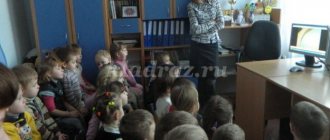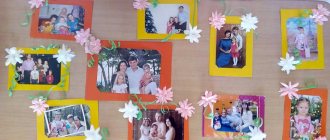Project in kindergarten for older preschoolers 5-7 years old on legal topics
Project “Great Rights for Small Citizens”
Dear residents of the “Ped-piggy bank”, I would like to bring to your attention my experience of working on children’s rights.
“Someone's legs walked along a winding path through the world. Looking into the distance with wide eyes, the little girl went to get acquainted with her rights. Nearby, my mother held her hand tightly and accompanied her clever girl on the journey. Both adults and children should know about the rights that protect them in the world.” Children’s rights today have become a “fashionable” topic, our country has embarked on the path of establishing a rule of law state, and in a civilized society, human rights and interests should be put in first place. A necessary condition for this is the awareness of people, their knowledge of their rights and responsibilities. Preschool childhood is a unique period in a person’s life, during which health is formed and personality develops. And at the same time, this is a period when the child is completely dependent on the adults around him - parents and teachers. Having started working on this topic, I set myself the following tasks: -to study literature, documents on this topic, -to acquaint parents with legal documents, with the history of the adoption of the UN Convention on the Rights of the Child and the rights enshrined in it, to give an idea of protection rights of the child, thereby increasing the level of legal culture of parents - introducing children in an age-appropriate manner to the basic documents on the protection of human rights and their rights. I planned all my work in three stages: 1. get acquainted with the documents, study the material. 2. plan work with children. 3. work with parents. Having studied the literature and documents, I found out for myself that children’s rights are a set of rights enshrined in international documents on children’s rights. The main documents include: -Declaration of the Rights of the Child -Convention on the Rights of the Child -World Declaration A declaration is an official or solemn statement. A convention is a contract, an agreement that sets out the rules forming for the parties. November 20 is considered to be the day of legal knowledge. And then there is a list of the rights of the child that are included in the convention. Then I prepared the games, selected the appropriate literature, and began working with the children.
We started with an introductory conversation, looked at the pictures, found out what rights exist and what rights we, children, have. We outlined what rights we would like to get acquainted with in detail. When getting acquainted with the “right to a name”, I held conversations: “What does your name mean”, “My full name”, held a competition “My name”, where each child, together with their parents, made a business card of their name, played games “Affectionate” name”, “Recognize by voice”, “Name is growing”.
When getting acquainted with the “right to housing”, I held conversations “The house you live in”, “My house is my fortress”, played the games “Give me your address”, “Who has the right to live in my house”, read the fairy tale “The Three Little Pigs” ", "", held a drawing competition "My Home".
Getting acquainted with the “right to live in a family,” we talked about how to take care of our loved ones and how to help them. The children talked about their families and how they relax. Family photo albums were prepared together with the parents. Conducted a drawing competition “My Family”. We played games “Mothers and Daughters”, My Family.” Homework was to make a family tree.
We finished all the work with the final quiz “Great rights for a small citizen”, remembered fairy tales, riddles, played games. When working with parents, the first stage was the use of visual information. A parent meeting was held on this topic. To identify the level of pedagogical culture, I conducted a series of questionnaires: “What kind of parent are you,” “my attitude towards punishment.” I used sliding folders. The parents showed activity, invention and creativity when doing homework: “family tree”, drawings “my family”, “compiling a family photo album”. To summarize, we can say that all this work helps to establish trusting relationships with children’s families, parents become full participants in the educational process, children feel comfortable at home and in the garden. The main idea of work on the legal education of preschool children is the recognition of the child as a full-fledged and full-fledged person: free and responsible, knowing his rights. The Convention proclaims the child to be an independent subject of law, and our task is to bring the Convention to the consciousness of children in an accessible form. And it is better to start such work with children of older preschool age. Because children 5-7 years old adequately perceive this material and manage their behavior. By the end of preschool age, the child becomes active, aware of himself as a subject of his own activities in relationships with adults and peers. Thank you for your attention.
We recommend watching:
Pedagogical project in the junior and middle groups of preschool educational institutions Research project in the preparatory group Classes with older preschoolers 5 - 7 years old. One day project Project in the middle group “Mushrooms”
Similar articles:
Development of communication skills in design and research activities in preschoolers
Project for children of the senior group “Our cheerful garden”
Creative project in the senior group on the topic “The Mysterious World of Insects”
Didactic game “Let every child know that he has different rights”
Goal: to consolidate in children knowledge about the rights to love and care, rest and leisure, good nutrition, education and medical care.
Material: cube with photo illustrations on children's rights.
Rules of the game: Players must explain the rights of the child, which are shown in the picture.
Game progress: Children stand in a circle. At the teacher’s signal, the children begin to pass the cube into each other’s hands. When the signal sounds, the child receiving the cube looks at his picture and talks about the child's right side, which is depicted on it. The game continues until all the illustrations have been recycled.
Leisure scenario in the preparatory group “About the rights of the child - while playing”
Free time on legal topics in the preparatory group. Leisure scenario in the preparatory group “On the rights of a child - a game” with presentation.
Goal: To give children a general idea of their rights. Contribute to the development of legal worldview and moral ideas. Develop the ability to reason, compare, and draw conclusions. Develop self-esteem and respect for others. Material: Demonstration: A book with “Child Rights” written on the cover; character Baba Yaga; Baba Yaga's House (hut) paper flower “Children's Rights”; ball; musical accompaniment: audio recording of the voices of forest birds. Delivery: each child - a pillow - “thought”, didactic game “Everyone has rights”, “Name”, “Home”, “Treatment”, “Education”, “Love and care”. In the group room there is a place for outdoor games, where there is Baba Yaga’s house, covered with white fabric (pillows are placed in front of it, flowers are placed on the side). Teacher: I'm glad to meet you. Today we will get acquainted with a wonderful book. This is called “Children's Rights” (shows). This wonderful book will teach you about children's rights.
Baba Yaga appears. (can be a doll or an adult role)
Baba Yaga (takes a book from the teacher) Mala, you still have the right to study! And I read this book. (goes to the open play area, hides behind his hut). Teacher: Well, Baba Yaga! He took our book and he did it! What are we going to do now? (children's answers) Well, let's contact her and return our book. Children and teacher move to the open playground. Teacher (pointing to the house covered with a white cloth). Behind this snow-capped mountain in the forest lives Baba Yaga. It is difficult to overcome the mountain, but magical clouds will help us. (points to the pillows). Get in quickly and fly! (Children sit on the pillows) We will fly very fast, so close your eyes so they don’t get wet from the wind, let’s take off! Hold on to the clouds. Feel how fast we fly! The mountain is already behind us.
What else to read: Lessons based on the author’s didactic game for children of senior preschool age “Riddles of the Flora of Flowers”
Includes a voice recorder with bird sounds. Slowly increasing the volume. Removes fabric from Baba Yaga's house. Educator. Can you hear? Birds are singing. We're flying into the forest. We open our eyes. We land in a clearing. Here is Baba Yaga's hut. (Children get up from the pillows and come home). In a deep forest there is a hut with chicken legs on the edge. It is located a stone's throw from the forest where Grandma Yaga lives. - Shall we knock? (Baba Yaga appears)
Baba Yaga: Who are they? Why did they come? I'm not expecting guests. Teacher (turns off the recorder). Oh Baba Yaga, how angry you are, what a rude voice you have and your hostile words. You even scared the birds with your scream. Baba Yaga. Stop talking! Why did you come? (Children's answers) Teacher: Yes, Baba Yaga, we came to pick up the book that you stole from us. Baba Yaga. He didn't steal anything from you, he just took it. You do not own the rights to this book. And only the children and grandchildren of the Tsar Sultan and the Nightingale the Thief can count on all the rights written in the book. And also children who believe in Baba Yaga and Koshchei the Immortal, and the same skin color as Baba Yaga, and in whom you believe. So, Baba Yaga, you are wrong, give us back the book! Baba Yaga. Oh oh! Gorgeous thing! Come on, come on! come here to me, you number one. Educator. Baba Yaga, why do you speak so strangely to children? After all, they have a name, each has its own. Baba Yaga: Names? Why give them names if the children are still small? They can handle the numbers too. Educator. Do you agree that all children are the same? (No) Prove it to Baba Yaga. (One child has black hair and blue eyes, he is tall and slow. The other child is blond, with brown eyes, with freckles. He is very cheerful and active. Etc.) Well, Baba Yaga, have we convinced you? Do you agree that every child has the right to his own name from the day he is born? Didactic game “Everyone has rights” Finger gymnastics “Lonely Grandma Yozhke” Lonely Grandma Yozhke. There's an owl and cats next to her, and she doesn't like chicken legs either. Everyone is afraid to meet her, they don’t want to sit in the oven. Grandma was wondering how to attract guests? She wouldn't like the devil and would go in for sports and invite her neighbors for tea and cake. And then the chicken legs danced on the path, and the owl and cats sang along with the guests. /TO. Strelnik / Baba Yaga: Well, I admit that you have the right to do so. Educator: Then let's introduce ourselves to Baba Yaga, and the echo will help us. Sitting game “Echo” Children stand in a circle, take turns saying their names and passing the ball to each other, the rest repeat them in chorus. Educator. And now, Baba Yaga, please return the book to us so that we can learn about the rights of other children. Baba Yaga: I will return it to you if your mother works for someone in the library. Teacher: And why? Baba Yaga: Since only the children of librarians have the right to read books, only the children of builders can live in houses, and the children of doctors are supervised. Teacher: Well, you said it! Children, do you think what Baba Yaga said is correct? (Children's answers). Baba Yaga, every child has the right to a home, food, care and education. (Hand out tokens - symbols “Home”, “Treatment”, “Education”, Baba Yaga goes to her home)
What else to read: Games in early and early preschool age
Educator: For some reason I felt sorry for Baba Yaga. Maybe she does bad things because no one loves her, no one cares about her. After all, everyone has the right to love and care. You all have the right to this. No one even wished Baba Yaga a happy birthday. Let's do it. We collect the flower by petals and give it to him as a gift. Outdoor game “Collect a flower”
They collect flowers and knock on the door of the hut. Baba Yaga comes out. The children congratulate her on her birthday and give her flowers. Baba Yaga is embarrassed, thank you, Teacher. it's time for us to return. Ride your clouds and fly home. Baba Yaga: Wait! Get your book. I am also capable of good deeds.
Educator: Thank you, Baba Yaga. Come. We have many other interesting books and games. Until we meet again! Baba Yaga. Until we meet again! Thank you for the invitation, I will definitely come. Educator. Everything is fine? Let's fly! Don't forget to close your eyes.
(Turns on a tape recorder with a recording of bird voices, throws a rag over Baba Yaga’s house. Baba Yaga leaves.) Did you like the trip? What did you like most? (Children's answers). What rights did you learn about your rights today? (Children’s token responses are symbols)
Well done, remember your rights. We will meet again in this book, which will introduce you to other rights. Thank you all. It was very pleasant and interesting for me to be with you.
Didactic game “Fold the flower”
Goal: to consolidate in children knowledge about the great rights of the child. Teach children to understand their abilities by following certain rules and rights. Promote a negative attitude towards manifestations of aggression, cruelty, and exploitation. Encourage the desire to be honest.
Material: red and green circles with images of children's faces, multi-colored petals on which are pasted images depicting the child's rights to a good life or their violation.
Rules of the game: players must place petals around a green circle, on which are pasted images representing the rights of a child to a decent life, and around the red circle place petals representing a violation of the rights of a child.
Game progress: Two or more children can participate in the game.
Option 1
2 circles (green and red) are placed on the table in the center, and the petals on the table are placed with the image on the table. Children take turns choosing a petal, examining it, and explaining whether the child’s rights are protected or violated. If the petal depicts an image of protecting the rights of a child, it is located around a green circle, and if the rights of a child are violated, then around a red circle. The game ends when both flowers are collected.
option 2.
Two children are playing. The child is asked to fold a flower, the petals of which depict images of protecting the rights of the child, and the second child - images of violations of the rights of the child. The player who composes the flower first wins.
Didactic game “Chain of rights of the child”
Goal: to strengthen children's knowledge about the rights of a small child. Improve your reading skills. Develop fine motor skills of your hands. Cultivate attention and visual perception.
Material: parts of the “chain”: some are a graphic representation of the rights of the child, others are a verbal explanation of the graphic images.
Rules of the game: to verbally explain the rights of the child, children choose pictures with graphic images, explaining their content, forming a chain. Vice versa.
Game progress:
Option 1
The provider or child reads a verbal explanation of the child's rights to parts of the chain. Children find suitable graphics, connect them with a cable and talk about the child’s right that is depicted on it.
What else to read: Games - trainings as a means of developing safe behavior skills in preschoolers.
option 2:
Children choose for themselves parts with a graphic representation of the rights of the child and, with the help of the teacher, or independently find the appropriate verbal explanation. And they are connected with a cord. The one who connects the chain the fastest wins.






